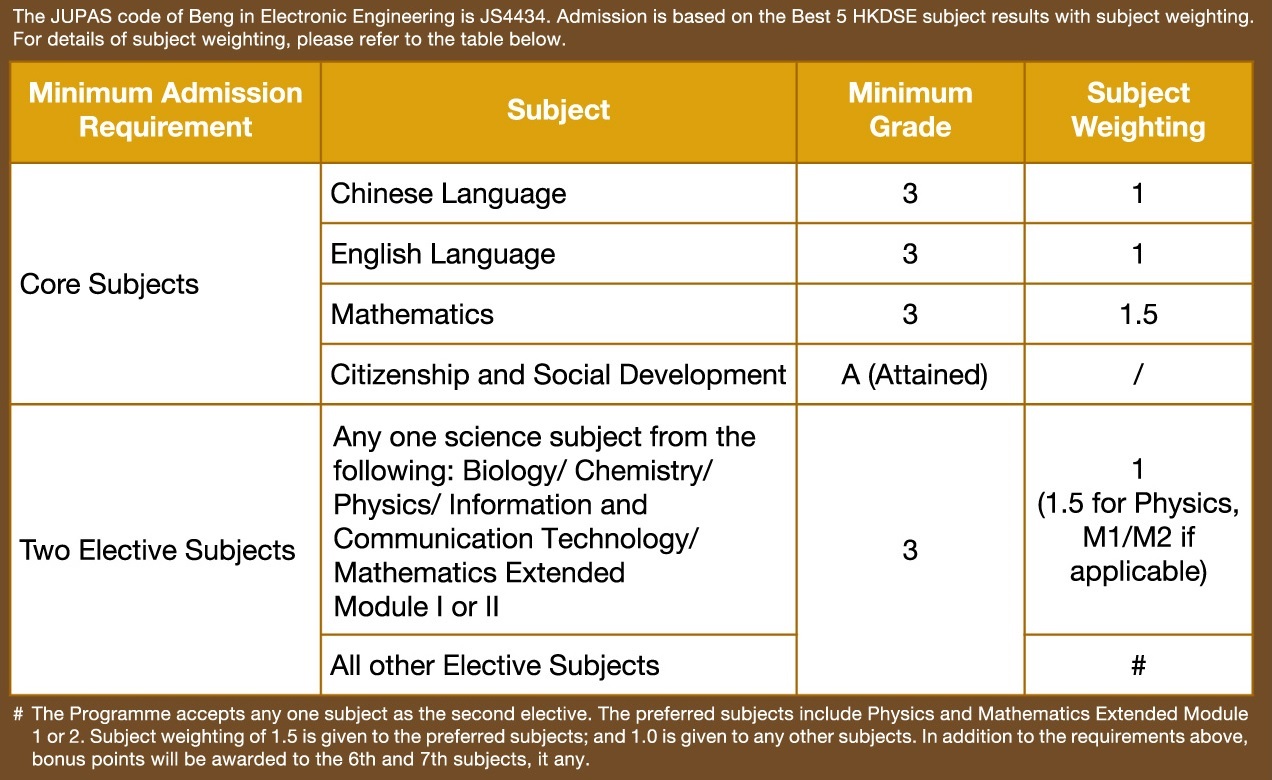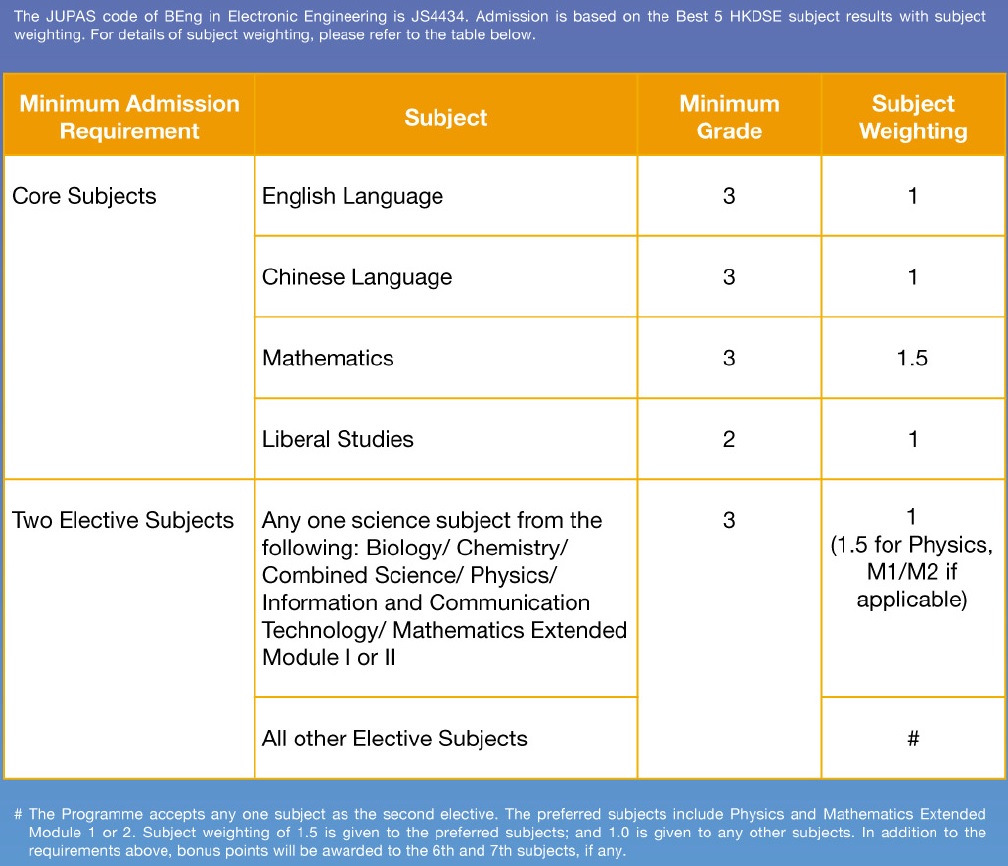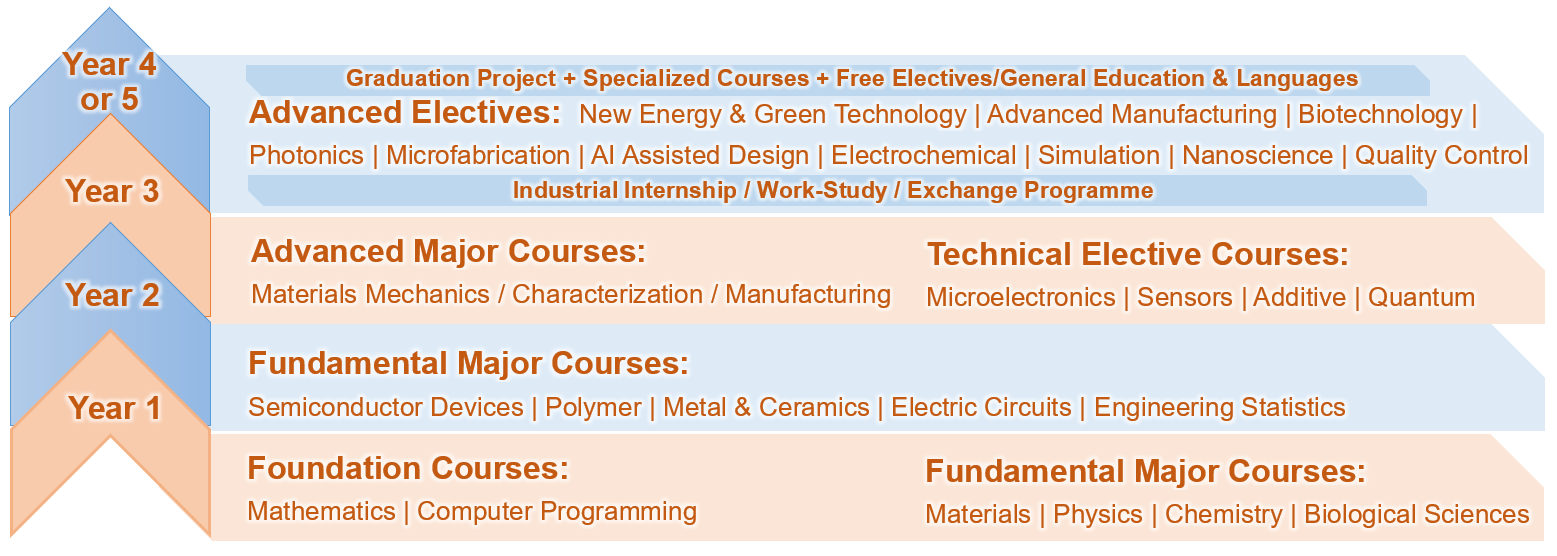Homepage
Home
JUPAS Admissions
Secondary school students taking the Hong Kong Diploma of Secondary Education (HKDSE) Examination should apply for admission through the Joint University Programmes Admissions Systems (JUPAS). The JUPAS code of CUHK ELEG (BEng in Electronic Engineering) is "JS4434". For details, please refer to the website of Office of Admissions and Financial Aid (OAFA), CUHK.
Programme Entrance Requirements

Non-JUPAS Admissions
Applicants who are seeking admissions on the strength of other qualifications other than HKDSE should apply through the Non-JUPAS Admissions Scheme:
For Local Entrants: Local applicants who are not using the results of Hong Kong Diploma of Secondary Education (HKDSE) for admissions purpose such as International Baccalaureate (IB), GCE-AL, HKALE, SAT, AP will be considered as Non-JUPAS applicants. They can apply for admission via the Non-JUPAS (Yeas 1) Admissions Scheme.
For Sub-degree Holders: Local students who possess Associate Degree or Higher Diploma qualifications, and have attained an acceptable level of proficiency in the English and Chinese languages, will be considered as Non-JUPAS applicants and can apply for first year admission via the Non-JUPAS (Year 1) Admissions Scheme and/or senior year admission via the Non-JUPAS (Senior Year Admissions).
For International Applicants: Applicants who need visa/ entry permit to study in Hong Kong will be considered as international students. They can apply for admission via the International Students Admission Scheme.
JUPAS Admissions
Secondary school students taking the Hong Kong Diploma of Secondary Education (HKDSE) Examination should apply for admission through the Joint University Programmes Admissions Systems (JUPAS). The JUPAS code of CUHK MASEN (BEng in Materials Science and Engineering) is "JS4470". For details, please refer to the website of Office of Admissions and Financial Aid (OAFA), CUHK.
Programme Entrance Requirements
|
Four Core Subject(s) |
Minimum Level |
Subject Weighting |
|
English Language |
3 |
1 |
|
Chinese Language |
3 |
1 |
|
Mathematics (Compulsory Part) |
3 |
1.25 |
|
Citizenship and Social Development |
A (Attained) |
/ |
|
Two Elective Subject(s) |
Minimum Level |
Remarks [Please indicate specific / preferred subject(s)] |
|
Any one Science subject from the following: Mathematics Extended Module 1 or Module 2/ Biology/ Chemistry/ Physics/ Information and Communication Technology |
3 |
1 (1.25 for Physics/ |
* In addition to the requirements above, bonus points will be awarded to the 6th and 7th subjects, if any.
大學聯合招生入學
參加香港中學文憑考試(HKDSE)的中學生應通過大學聯合招生辦法(JUPAS)申請入學。中大電子工程學(ELEG)的聯招編號是「JS4434」。 詳情請參閱香港中文大學入學及學生資助處網頁。
課程入學要求 (只提供英文版)

非聯招計劃申請入學
如欲以非香港中學文憑考試(HKDSE)的其他學歷申請入學,申請人應通過非聯招計劃 (下稱:非聯招)申請入學:
本地學生: 持有IB、GCE-AL、HKALE、SAT、AP等非香港中學文憑(HKDSE)成績入學的本地學生,將被視為非聯招申請人。申請人可通過非聯招(一年級)入學計劃申請入學。
副學位持有者:擁有副學士學位或高級文憑資格並達到香港中文大學入學中英文水平的本地學生,將被視為非聯招申請人。申請人可通過非聯招(一年級)入學計劃和/或通過非聯招(高年級)入學計劃申請入學。
國際學生:需要學生簽證/進入許可證方可在香港讀書的申請人將被視為國際學生。申請人可通過國際學生入學計劃申請入學。
Technological advances in electronic engineering are in sync with the contemporary era and incorporated everywhere in our daily lives: in computers, telecommunication networks, smart phones, digital cameras, medical equipment, security and surveillance systems, etc. The work of electronic engineers includes the invention, design, development and manufacture of all kinds of analogue and digital electronic systems, as well as the development of the software needed to make these systems function.
Our Department was the first to introduce undergraduate programme in the Faculty of Engineering, CUHK. We have been committing to nurture future leaders in the electronic engineering field, and to invent advance state-of-the-art technology. The Electronic Engineering Programme features a dynamic and adaptive curriculum with a wide coverage on the latest technological developments. The courses offered are designed to convey both theoretical and practical knowledge and to provide balanced training in both hardware and software skills. The major topics of study include: Multimedia and Signal Processing, Integrated Circuits (IC) Technology, Microwave Engineering and Wireless Communications, and Microelectronics and Photonics. Apart from hands-on experience gaining from group projects, students are also encouraged to join the Work-Study programme and spend one year working in industry to enrich their practical experiences.
The 4-year programme of study leads to a Bachelor of Engineering (BEng) honours degree, accredited by The Hong Kong Institution of Engineers (HKIE) and The Institution of Engineering and Technology (IET). Students graduating with all requirements fulfilled would be recognized as qualified engineers.
Moreover, graduates are eligible to join Scheme A training of HKIE in the disciplines of Control, Automation & Instrumentation (CAI) / Electronics (ENS) / Information (INF). For more details, please refer to Eligibility to Scheme “A” Training of Engineering Programmes Accredited by the HKIE(Curriculum under “334” Academic Structure).
Subcategories
Undergraduate Programmes Article Count: 110
MPhil-PhD Programme Article Count: 53
MSc Programme Article Count: 35
Student Admission Article Count: 0




